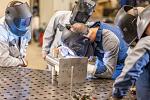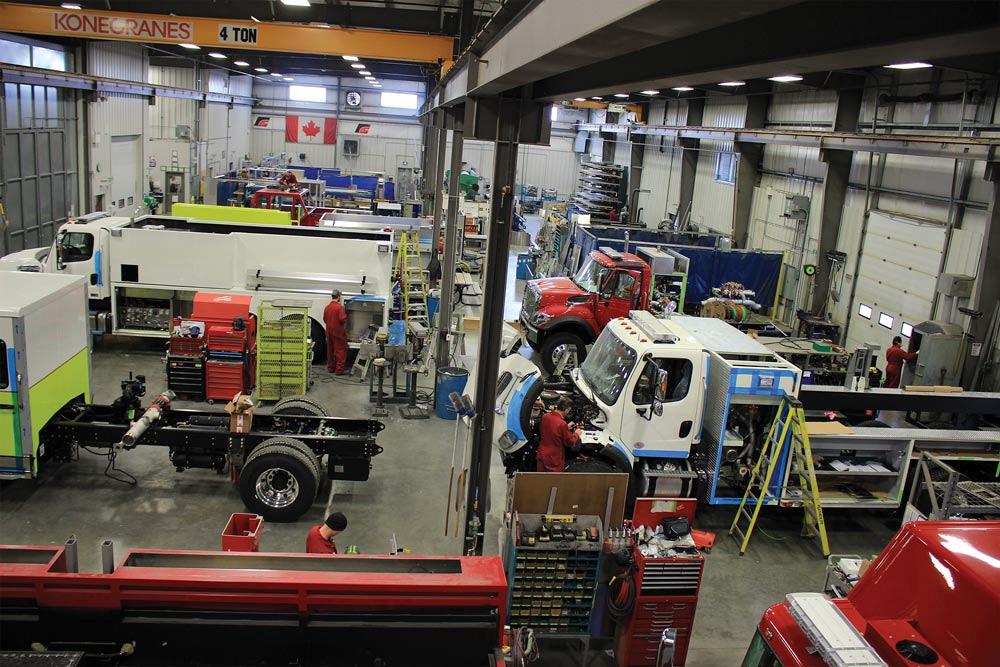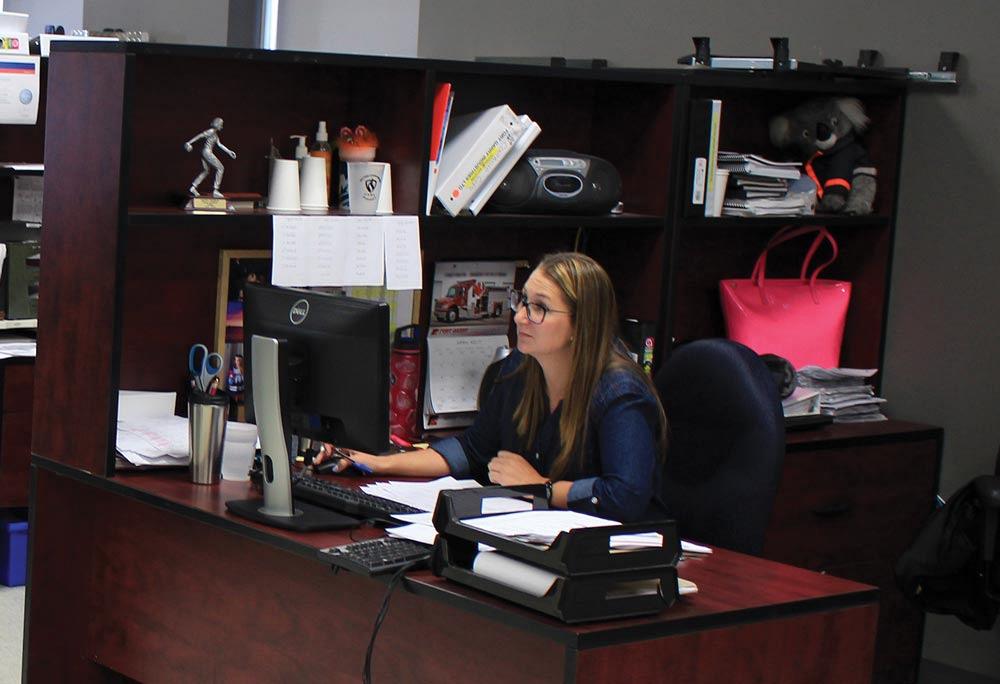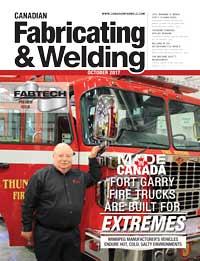- FMA
- The Fabricator
- FABTECH
- Canadian Metalworking
Fort Garry Fire Trucks are built for extremes
Winnipeg manufacturer’s vehicles endure hot, cold, salty environments
- By Sue Roberts
- October 23, 2017
- Article
- Made In Canada

Rick Suché, president of Fort Garry Fire Trucks in Winnipeg, is shown with a truck about to be delivered to Thunder Bay Fire Department.
Not many manufacturing facilities are built over a 10,000-gallon water tank. Fort Garry Fire Trucks’ (FGFT) shop in Winnipeg, Man., is. The tank is tucked under the pump test area of the 52,000-sq.-ft. facility to provide recirculating water for water delivery tests that are part of the fire truck certification process.
That is only one of the many documented inspections required for the FGFT vehicles with names that any fire should find intimidating. Names like Terminator, Crusader Pumper, and Duster. “Many of our vehicles have 60 tests, each chronicled in their own document,” said Rick Suché, company president.
Suché said that in 1994 FGFT was the first North American emergency vehicle manufacturer to receive an ISO 9000 rating. In 2008 it upgraded that certification by achieving ISO 9001. “We know where every piece on a vehicle comes from and who worked with it. Those comprehensive records apply to everything from welding to purchased components.”
Endless Design Choices
Every fire truck is a unique creation, specifically designed for the fire department and the geography it serves. For example, an East Coast truck may need to fit down narrow streets of an older, compact town. Most city trucks probably have smaller tanks because they have access to fire hydrants. If the truck is going to a small town, it might be the only vehicle available to respond to a large variety of emergencies. It will need more rescue equipment, which means more fabricated spaces to stash emergency gear.
A truck for the western provinces may have more room to manouever and a larger frame. It possibly needs to handle hills and mountainous terrains or be able to pump and roll at 20 kilometers per hour to fight wildfires. A big pumper tanker, although it can fight a fire, is typically used to haul water from a source like a local lake for other vehicles to use in the fight.
“Trucks have to withstand heat as well as cold,” said Suché. “A specialty of ours is the enclosed pump house. Rather than just heating the crew cab, we also heat the pump house so the pump operator has a warm area to work in frigid weather. We got a letter from a firefighter in Nunavut thanking us for this type of construction because they had fought a fire for 14 hours in -76 degrees F--without the wind chill. We build for the extremes.”
Rugged construction and the ability to perform in adverse environments have gained FGFT fire trucks and rescue vehicles an international reputation. They serve communities throughout North America, as far north as the Arctic Circle, and in Guatemala, West Africa, the Bahamas, United Arab Emirates, China, Cuba, and Pakistan.
Customer-driven Designs
Requests for vehicle configurations enter the shop in a variety of ways, said Suché, from hand drawings to taped-together cardboard models. Work begins with a pre-production meeting with the customer to determine specific needs and choose the basic model to begin the design process. The 106 models have descriptive names like 12-ft. Rescue, 20-ft. Rescue, Pumper Tanker, Urban Interface Duster, Mini Pumper Rapid Attack, Wildland Terminator, and Specialized Industrial Unit.
Choosing truck features from over 10,000 options comes next. Then, customization. The customer approves everything from the vehicle frame to the foam system to the placement of compartments—all to meet their specific needs.
“We’ve built military trucks that house bomb robots. Some trucks, used for the Olympics, included cameras for facial recognition from over a mile away. Our rescue trucks carry a lot of equipment for vehicle extrication, water and trench rescue, and all types of rescue operations that fire departments find themselves doing.“The design process doesn’t start out with a clean piece of paper, but almost. We begin with a truck model, cut it apart to fit in features like ice rescue equipment, and figure out where to put the special equipment that the customer needs,” said Suché.
“Our 3-D modeling software basically designs the truck. It takes anything that is standard and releases the bills of material. Anything not standard goes to engineering. We use mass customization. Everything is made in modules so they can be added together to make the body.”
Ten engineers, representing nearly 10 per cent of the company’s 120 employees, work to incorporate the changes needed to accommodate customizations that affect electrical, plumbing systems, pumps, and fabricated bodies.
Attention to Construction Details
Everything is set up by job number. Operators, assemblers, and welders use tablets to communicate with engineering so they don’t need to leave the shop floor.
On average, 10 trucks are in final assembly at a time. They enter the assembly bay when the body is painted, the doors are ready to put on, and the pump assembly is complete. About 30 days later they are ready to head for their new home. “The chassis comes in and the pump and body are there for assembly,” said Suché. “These things have been worked on before the truck components are brought into the assembly bay.”
Construction details for every vehicle include welded backing plates for all access step mounts, structural floor reinforcement under lower compartments, and spring-loaded body mounts. Swing-out gauge panels make it easy for fire hall maintenance personnel to access gauges and electrical components. Removable wheel skirts allow access to chassis springs. Suspension work and removeable tail boards are designed to be easy to replace. Very few components are contracted out. Most parts are cut, bent, and welded on-site.
A Multicam CNC router cuts the sheet and plate components and drills the various sized holes for the lights and vents. Components for aluminum extruded subframes are cut on a Northfield Uni-Point saw with a TigerStop material positioning system. A 500-ton Accurpress brake creates the formed components. The various pieces are tack welded to form assemblies.
“Welded assemblies are all checked by the weld inspector. Then they go to sanding. Any seams that aren’t 100 per cent welded are caulked and sealed,” Suché said.
Urethane paint and a clear coat protect the finish. Exact color is important. FGFT offers 168 shades of red alone. Each vehicle has to look just right when it’s next to the other vehicles in a firehouse bay. The bodies and their finishes need to last 25 years under extreme salt conditions
Service Here or There
“We listen to what our customers want and try to mould ourselves around their needs. Then, once we’ve met the fire department’s build specifications, we still have to meet the mechanic’s needs. The design has to give mechanics access to everything on the vehicle, and it has to be easy for them to find a problem. The status of the various technical operations is displayed on the electrical board or multiplex screen so problems can be diagnosed at a glance,” said Suché.
“And we have to be able to service everything—all the foam, pump, computer, and electrical systems.”

Gerry Mychajlyszyn, plumbing engineer, is one of 10 design engineers who begin with a basic vehicle model and customize it to meet a fire department’s specific needs. Operators and assemblers on the shop floor use tablets to communicate with the engineering department.
Company service trucks, outfitted with $20,000 worth of spare parts, cross the nation to take care of problems that can’t be solved by the fire department mechanics. If an issue can’t be corrected in the field, a vehicle returns to the Winnipeg facility. Loaner trucks are available so a firehouse isn’t left with an empty bay.
“We also keep five to 10 stock trucks ready to go in case somebody’s truck has a disaster and a vehicle is needed now,” Suché said. Used vehicles are also available. Trucks are taken in on trade, refurbished, and brought up-to-date before they head to a new home.
Nearly 100 Years
Fort Garry Tire and Vulcanizing opened in 1919. The company fabricated rubber products, bonding rubber to steel for equipment like pulleys for the agricultural industry. Suché’s father purchased the company in 1976. Those vulcanized products are still available from the Fort Garry Rubber Division that is part of today’s FGFT facility.
“In the late 1920s the company started cutting Packards in half and making them into 19 passenger buses. We were a bus builder until the beginning of the Second World War when we needed the shop space to reline tires for the air force. We sold the bus business that was known then as Fort Garry Body Works. It was renamed Motor Coach,” said Suché.
“In the ‘50s and ‘60s our shop built anything and everything. That included some tanker trucks for Indian Affairs and forestry. The market demands led us to put some bigger pumps on the tankers. We took those trucks to some fire industry tradeshows.
“Today we’re Canada’s biggest fire truck manufacturer.”
Looking forward, Suché sees more trucks with more options, including expanded remote control features. “Bunker gear, protection for the fireman, is getting better so they can stay in a fire longer--which can be good or bad. But we’re also seeing robots equipped with nozzles that can go farther into a fire in place of a human.”
The biggest challenge, he said, is not knowing what changes will be made to the engines to make them more environmentally friendly. “The EPA redoes engine requirements every two or three years. They keep increasing the size of the exhaust systems. Until their prototypes are out, we don’t even know where the exhaust is going to be. That makes it hard to know how to fit in the pump and the compartments and components.
“And since everything on a truck hooks into the engine, engine changes make it necessary to redesign our computer tools so they will work. Staying on top of electronics is huge. We always hope we know what is coming because we are quoting and designing a year or more out.”
The company is positioned to increase from 1 ½ shifts to two to keep up with growth. Unskilled workers are usually hired and trained in-house. A full-time trainer is on the floor every day.“We’re running training programs all the time. To be a fire truck mechanic you need to be a bit of a mechanic, a bit of a plumber, and because everything is talking to computers, a bit of a computer geek. We just want to find good, young guys who want a career.”
FGFT by the Numbers
- 25-year vehicle guarantee
- 10,000+ vehicle options
- 2 years shy of 100th anniversary
- 12 months from order to delivery
- 106 fire truck models
- 4 trucks to service vehicles across Canada
- $20,000 worth of parts in each service truck
- 10 per cent of employees are engineers
- $85,000 to fly a service technician, tools, and parts to Nunavut
- 168 shades of red paint
Fort Garry Fire Trucks, 800-565-3473, www.fgft.com
Photos by Dave Stewardson.
About the Author

Sue Roberts
2135 Point Blvd
Elgin, IL 60123
815-227-8241
Sue Roberts, associate editor, contributes to both Canadian Metalworking and Canadian Fabricating & Welding. A metalworking industry veteran, she has contributed to marketing communications efforts and written B2B articles for the metal forming and fabricating, agriculture, food, financial, and regional tourism industries.
Roberts is a Northern Illinois University journalism graduate.
subscribe now


Keep up to date with the latest news, events, and technology for all things metal from our pair of monthly magazines written specifically for Canadian manufacturers!
Start Your Free Subscription- Trending Articles
Class is in session for college connections

BlueForge Alliance partners with Nuts, Bolts & Thingamajigs to develop Submarine Manufacturing Camps

Portable system becomes hot tech in heat treatment

Orbital tube welding webinar to be held April 23

Cidan Machinery Metal Expo 2024 to be held in Georgia May 1-2

- Industry Events
MME Winnipeg
- April 30, 2024
- Winnipeg, ON Canada
CTMA Economic Uncertainty: Helping You Navigate Windsor Seminar
- April 30, 2024
- Windsor, ON Canada
CTMA Economic Uncertainty: Helping You Navigate Kitchener Seminar
- May 2, 2024
- Kitchener, ON Canada
Automate 2024
- May 6 - 9, 2024
- Chicago, IL
ANCA Open House
- May 7 - 8, 2024
- Wixom, MI


















